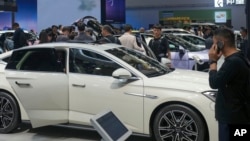The European Commission said Wednesday it plans to impose increased duties of up to 38% on imported Chinese electric vehicles starting in July, escalating a trade dispute that Brussels sees as part of an effort to protect EU-bloc manufacturers.
The move, which Beijing officials have slammed as "protectionist," comes less than a month after Washington quadrupled U.S. tariffs on Chinese electric vehicles to 100%.
The EU's executive branch said its decision to nearly quadruple duties from the current level of 10% follows several probes — some ongoing — into whether Chinese green technology producers are dumping government-subsidized goods on EU markets, giving Chinese automakers particularly an unfair advantage.
EU officials also said the new tariffs, slated to kick in after dispute-resolution talks conclude on July 4, are provisional and contingent upon findings of an EU probe into Chinese manufacturing subsidies that will be completed November 2. After that date, definitive duties, typically enforced for a minimum of five years, could apply.
Speaking at a regular press briefing on Wednesday, China’s Foreign Ministry spokesperson Lin Jian called the anti-subsidy investigation “a typical case of protectionism.” He also warned that the measures disrupt automobile supply chains and would eventually hurt Europe’s own interests.
In a statement posted on its official website, Chinese Commerce Ministry spokesperson He Yadong said that the tariffs are devoid of “factual and legal basis” and that they constitute a “weaponizing" of "economic and trade issues.”
European commissioners defended the move, citing findings from an October 4 probe that found China’s electric-vehicle supply chain “benefits heavily from unfair subsidies ... and that the influx of subsidized Chinese imports at artificially low prices therefore presents a threat of clearly foreseeable and imminent injury to EU industry.”
Some of Europe’s largest manufacturers who sell in Chinese markets, including BMW, saw shares drop Wednesday over fears of Chinese retaliation.
"The European Commission's punitive tariffs hit German companies and their top products," posted German Transport Minister Volker Wissing on X, largely echoing concerns expressed by officials at Volkswagen and Mercedes Benz, two of Germany’s notable carmakers.
"Cars must become cheaper through more competition, open markets and significantly better business conditions in the EU, not through trade war and market isolation," the post continued.
Chinese automakers seemed less concerned.
"The EU's provisional tariffs come basically within our expectations, averaging around 20%, which won't have much of an impact on the majority of Chinese firms," said Secretary General Cui Dongshu of the Chinese Passenger Car Association.
Steffen Hebestreit, a German government spokesperson, welcomed possible resolution through dispute talks.
The European Commission says that its probes aim to stop unfair competition and market distortion, and that rates can be enforced on a company-by-company basis. Chinese manufacturers that have assisted with the EU probes face rates of 21%, while uncooperative firms can expect to see the new rate of 38%.
Chinese-made wood flooring imports, medical devices, wind turbines and solar panels have also been under investigation.












